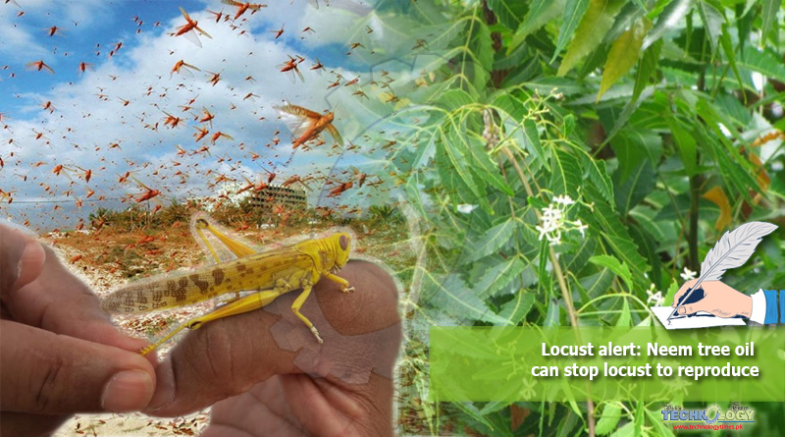Neem tree oil is powerful enough to kill locust and the most voracious insects. It inhibits an insect’s ability to reproduce. Dr Siddiqui was the first scientist to bring the anthelmintic, antifungal, antibacterial, and antiviral constituents of the Neem tree.

The locust attack in East Africa, eastern Yemen, and southern Iran has become extremely alarming since hopper bands and new swarms are rapidly increasing due to widespread rainfalls in late March. The most suffering countries in East Africa are Kenya, southern Ethiopia and Somalia.
Kenya is pioneering the use of an organic, locally grown pesticides to battle against swarms of locust devastating crop in East Africa. The organic alternative is a product made from the leaves and barks of neem (Melia azadirachata) trees. Neem kills over 350 insects that are harmful to plants.
Neem is totally nontoxic and completely safe for humans and for other environment friendly insects like bees, worms etc. But at the same time, it is powerful enough to kill locust and the most voracious insects. Most of these discoveries still remain vital natural ingredients of various medicines as well as biopesticides.
The neem expert Dr Salimuzzaman Siddiqui
The world-renowned Pakistani scientist, Dr Salimuzzaman Siddiqui, conducted extensive research on Neem and other bitter plants. He extracted compounds from neem tree which are stable and found in substantial quantities. These compounds also servs as natural insecticides.
Dr Siddiqui was the first scientist to bring the anthelmintic, antifungal, antibacterial, and antiviral constituents of the Neem tree to the attention of natural products chemists. In 1942, he extracted three bitter compounds from neem tree oil, which he named as nimbin, nimbinin, and nimbidin respectively. The process involved extracting the water insoluble components with ether, petrol ether, ethyl acetate and dilute alcohol.
Scientists believe that no other plant has as much variety of products or has as many exploitable by-products as neem tree has. The neem tree ushers a new era in bio-pesticides, this can reduce the population growth of pest. As well as, reduce deforestation, erosion, and excessive temperature of the globe.
Locust attack current situation
Food and Agriculture Organization (FWO) declared that the current locust infestation is the worst in Kenya in 70 years, threatening millions of people with hunger.
According to FAO, the widespread rains in late March are quite conducive to allow new swarms to mostly remain, mature and lay eggs. While few swarms could move in other countries of this region. They may move from Kenya to Uganda, Sough Sudan, and Ethiopia.
During the month of May, the eggs will hatch into hopper bands, which will form new swarms in late June and July. This is exactly the same period when harvesting is started. And so, it is becoming frightening threat to food security and livelihood.
The same situation is happening in Iran and Yemen. Along the 900 km long coast of southeast Iran, the swarms laid eggs that are hatching, and forming hopper bands. The late March heavy rains caused another generation of locust breed and more increase during the month of May. This increase of locust will further extend to province of Balochistan, Pakistan.
The Oman and Yemen borders are also under locust threat, where swarm breeding in eastern Yemen is visible, that will cause hopper band to create more increase in locust numbers.
Studies have found neem products to inhibit an insect’s ability to reproduce. With locusts the main thing is to stop them from mating. Their mating cycle is very quick and once they have reached the fifth instar, they are flying, and they are swarming.
